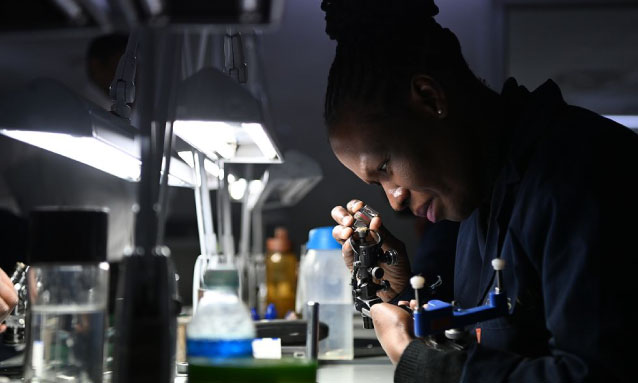
1 July 2024
Three Botswana women creating De Beers’s magnificent stones speak to Harper’s Bazaar about the beauty below the surface.
Last week in Paris, luxury jeweller De Beers debuted its “Forces of Nature” collection, which pays homage to the wild, natural world of Botswana, where it sources its gems. Inspired by eight animals native to the African country, the range includes cascading diamond chokers, twisted and layered earrings encrusted with the shimmering clear stones, and red-carpet-worthy statement pieces inspired by horns, flowers, leaves, and waves.
Ahead of the collection’s debut, Harper’s Bazaar spoke to three women behind the diamond brand’s show-stopping creations—engineer Tumisang Sebeso, Onneile Moroka from the Round Stones department, and Lame Sebobi from the Fancy Stones department—about the story ingrained deep in the Earth’s most precious stones, and the impact these glittering minerals have had on their own lives, and on Botswana.
De Beers, which in 2023 produced around 32 million carats of conflict-free diamonds, employs hundreds of men and women in its different departments—each of which specialises in a different kind of diamond cut. Onneile Moroka is the head behind the company’s round stone polishing department. With 15 years of experience, she assists with diamond repairs and trains others in polishing large, multi-carat stones.
Her team at Finestar Diamonds—a polishing company that De Beers partners with—is mostly made up of women, and she says that in the span of her long career, she has seen a big “boost in employment opportunities, benefiting many of us,” as more and more diamond polishing companies have been opened in Botswana to meet the demand for the stones.
(It is important to note that despite diamond companies’ complicated history with conflict or “blood” diamonds, none of Botswana’s diamonds over the past two decades can be classified as conflict diamonds.)
Amid De Beers’ Building Forever movement, which, among other things, promises to achieve gender parity across their workforce by 2030, Tumisang Sebeso, an engineer at Orapa mine, explains that she feels especially fortunate to be working with and learning from a group of women in all the different leadership positions across diamond production.
“The industry and Debswana have come a long way in closing the gender disparity in the industry, and I look forward to playing my own role in ensuring that the existing gap is further closed, to pave the way for a future where seeing women in mining and leadership is the norm rather than an anomaly,” she says.
Sebeso is in her third year of the Engineer-In-Training graduate programme at Debswana Diamond Company, and her job at the mine is, essentially, to keep things running and ensure there are no structural defects that could negatively impact the quality of the stones.
Lame Sebobi, who is a diamond polisher at Finestar’s Fancy Stones department, also notes with a smile what we have not said so far: Diamonds are beautiful objects to be around!
“As a woman in this women-forward industry, I take pride in understanding how women appreciate their jewellery and strive to create pieces that reflect their unique style and elegance,” she says. But, the business is not only about superficial beauty, she insists.
Debswana, where Sebeso works, is one of the world’s most important diamond producers, and an equal partner of the Government of the Republic of Botswana and De Beers. It operates four diamond mines in the area—Jwaneng, Orapa, Letlhakane and Damtshaa—run by local professionals, and has a Corporate Centre in Gaborone. It also runs several primary schools in the area, as well as a hospital, for the community.
And, the diamonds themselves have many other uses.
“As much as diamonds are well known for adorning priceless pieces of jewellery, they play a much bigger role in our industry than most people are aware of,” Sebeso notes.
“Industrial diamonds, for example, play a crucial part in the lives of everyone here, as they are used in manufacturing industries for cutting and drilling machinery [for things like] construction and metalworking.”
For these women in the mines, seeing the economic impact the diamond industry continues to bring to Botswana is incredibly emotional. Sebobi says her people absolutely “rely on diamond mining,” and it brings her “immense pride” to play a role in both transforming rough diamonds into exquisite heirlooms, and in transforming her country’s history for the better.
Source: https://www.harpersbazaar.com/fashion/designers/a61424621/de-beers-diamonds-mines-women-interview/
About the author: ROSA SANCHEZ, Senior News Editor.
Rosa Sanchez is the senior news editor at Harper’s Bazaar, working on news as it relates to entertainment, fashion, and culture. Previously, she was a news editor at ABC News and, prior to that, a managing editor of celebrity news at American Media. She has also written features for Rolling Stone, Teen Vogue, Forbes, and The Hollywood Reporter, among other outlets.



